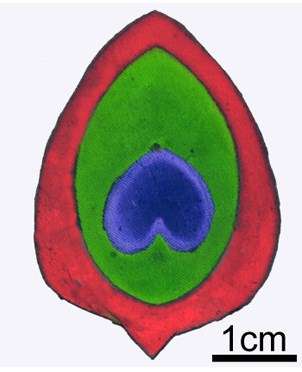Peacock colors inspire 'greener' way to dye clothes

"Fast fashion" might be cheap, but its high environmental cost from dyes polluting the water near factories has been well documented. To help stem the tide of dyes from entering streams and rivers, scientists report in the journal ACS Applied Materials & Interfaces a nonpolluting method to color textiles using 3-D colloidal crystals.
Dyes and pigments are chemical colors that produce their visual effect by selectively absorbing and reflecting specific wavelengths of visible light. Structural or physical colors—such as those of opals, peacock feathers and butterfly wings—result from light-modifying micro- and nanostructures. Bingtao Tang and colleagues wanted to find a way to color voile textiles with structural colors without creating a stream of waste.
The researchers developed a simple, two-step process for transferring 3-D colloidal crystals, a structural color material, to voile fabrics. Their "dye" included polystyrene nanoparticles for color, polyacrylate for mechanical stability, carbon black to enhance color saturation and water. Testing showed the method could produce the full spectrum of colors, which remained bright even after washing. In addition, the team said that the technique did not produce contaminants that could pollute nearby water.

More information: Yao Meng et al. Multiple Colors Output on Voile through 3D Colloidal Crystals with Robust Mechanical Properties, ACS Applied Materials & Interfaces (2017).
Abstract
Distinguished from the chromatic mechanism of dyes and pigments, structural color is derived from physical interactions of visible light with structures that are periodic at the scale of the wavelength of light. Using colloidal crystals with coloring functions for fabrics has resulted in significant improvements compared with chemical colors because the structural color from colloidal crystals bears many unique and fascinating optical properties, such as vivid iridescence and nonphotobleaching. However, the poor mechanical performance of the structural color films cannot meet actual requirements because of the weak point contact of colloidal crystal particles. Herein, we demonstrate in this study the patterning on voile fabrics with high mechanical strength on account of the periodic array lock effect of polymers, and multiple structural color output was simultaneously achieved by a simple two-phase self-assembly method for printing voile fabrics with 3D colloidal crystals. The colored voile fabrics exhibit high color saturation, good mechanical stability, and multiple-color patterns printable. In addition, colloidal crystals are promising potential substitutes for organic dyes and pigments because colloidal crystals are environmentally friendly.
Journal information: ACS Applied Materials and Interfaces
Provided by American Chemical Society




















